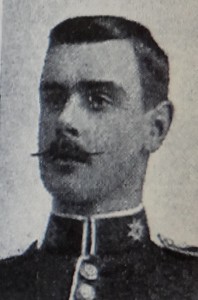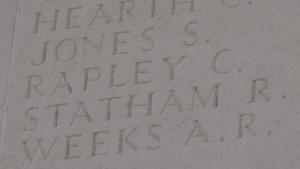 Regiment: 2nd Battalion, The Coldstream Guards
Regiment: 2nd Battalion, The Coldstream Guards
Service No: 7822
Date & place of birth: 6 September 1888 in East Dean, near Eastbourne, Sussex
Date & place of death: 16 September 1916 (aged 28) at Ginchy, France
Lance Serjeant Charles Rapley was a regular soldier with The Coldstream Guards who became the village constable at Cocking in 1911. He was killed in September 1916 during the battle of Flers–Courcelette, part of the Somme offensive.
Family background
Charles Rapley was born at East Dean, near Eastbourne in Sussex, the second of three children, and the only son, of Daniel Rapley (1863–1934) and his wife Rose May (1863–1908). Daniel was born at Steyning and married Rose in early 1885; Rose was the daughter of Hannah Simmonds Walder, who married John Kidd, who was 19 years older than her, when Rose was 15. The couple’s first daughter, Amy Rose, was born in late 1885, with Charles being born three years later.
Charles attended Purley national school, near Croydon, and Sidlow church school, near Reigate.
In the 1891 census, Daniel was described as a miller, and the family were living at Stoke, near Guildford. Ten years later, the family were living at Sidlow Bridge near Reigate, where Daniel was employed as a carter on a farm. Rose died in 1908 and at the time of the 1911 census, Daniel was still living at Sidlow Bridge with Amy. The younger daughter, Edith, was in service in Reigate, and Charles (now 22) was a private in 2nd Battalion, The Coldstream Guards based at Ramillies Barracks, Aldershot.
Military service
Charles had enlisted in the 2nd Battalion, The Coldstream Guards at Guildford on 5 May 1908. He spent three years with the Guards before joining the reserves in 1911. He then joined Sussex Constabulary as a Police Constable and was stationed at Broadwater, near Worthing before moving to Cocking, near Midhurst, in late 1913.
He was called up on mobilization on 4 August 1914 and on 12 August, a week later, the battalion was sent to France as part of the 4th (Guards) Brigade. The brigade was immediately in action, at the Battle of Mons and the subsequent retreat to Landrecies, followed by rearguard actions at Le Grand Fayt and Villers-Cotterets. In September, the brigade was back on the offensive at the Battle of the Marne before moving into Flanders for the First Battle of Ypres in November.
In a letter to PC William Treagus at Graffham in March 1915, Charles wrote that, of the men in his battalion who had served since August, there were only four survivors. In a later letter, he informed his friend that he had been promoted to Lance-Corporal; he also wrote that “the trenches are very good now, something different to what they were in the wet weather”. In September, the West Sussex Gazette reported that Sergeant Rapley had been on home leave at Cocking “very fit and looking remarkably well”. “Sergeant Rapley has experienced some of the stiffest fighting of the war, but so far has escaped injury.”
In August 1915, the battalion became part of the Guards Division. The Guards saw further action at the Battle of Loos in October 1915, in the Neuve-Chapelle sector through the winter of 1915–16 and in the Ypres Salient in the summer of 1916.
Death and commemoration
On 15 September 1916, the village of Lesboeufs, north-east of Amiens, was attacked by the Guards and captured from the Germans after eight days fighting. The Guards Division suffered heavy casualties on the opening days of the battle, without achieving any real success. Over 400 Coldstream Guards were killed on 15/16 September 1916.
Charles Rapley was killed on the second day of the battle near Ginchy, being shot in the head when in a shell hole; as his body was never recovered, he has no known grave and is commemorated on the Thiepval Memorial to the Missing of the Somme, about 8 miles from where he was killed, as well as on the Cocking village war memorial.

Following his death, Supt J Bristow of the Midhurst Division, West Sussex Constabulary wrote:
“He was a quiet, peaceful Police Officer, with a cheerful disposition, and a very straightforward and sober man. I have never heard anyone say a word against him in any way. He had no enemies in this police force, but was very much liked by the police and pubic. He has rendered a very great service to his country during the present war.”
He is also one of the 21 West Sussex Police Officers commemorated on the memorial at Horsham Police Station.